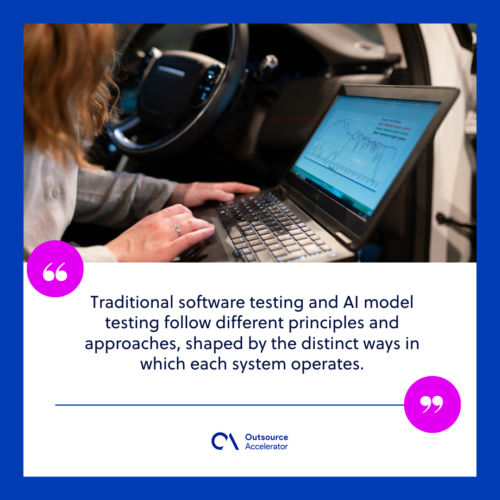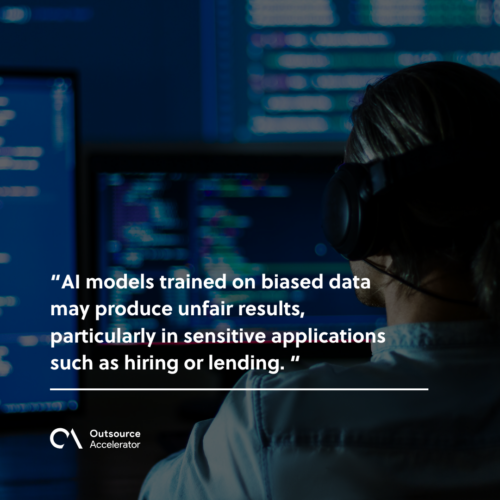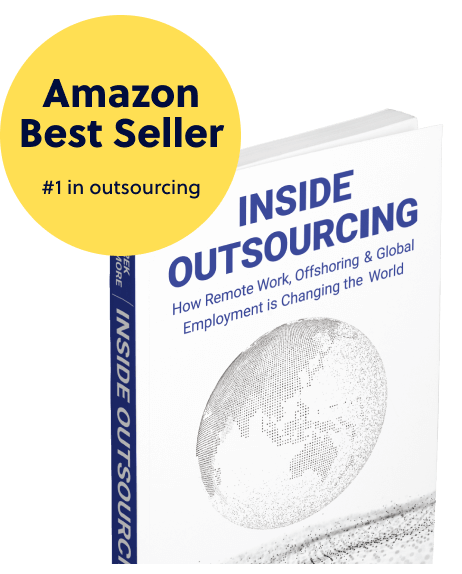Beyond traditional QA: Elevate software quality with AI model testing

AI model testing is the process of evaluating artificial intelligence systems to ensure they perform accurately, fairly, and reliably. Unlike traditional software, AI models learn from data and can evolve over time, making their behavior less predictable.
Therefore, testing must go beyond standard procedures to address unique challenges such as model drift, bias, and explainability.
Effective AI testing involves assessing performance metrics, validating against unseen data, and monitoring for unintended behaviors. For instance, a recent study by Vals AI found that 22 AI models from major tech firms averaged below 50% accuracy on basic financial tasks, highlighting the importance of rigorous evaluation.
This article serves as a quick guide to understanding AI model testing, a vital aspect of modern quality assurance for developing better software products.
Traditional software testing vs. AI model testing
Software testing is essential in delivering reliable digital products. However, with the rise of artificial intelligence, testing methods must evolve.
Traditional software testing and AI model testing follow different principles and approaches, shaped by the distinct ways in which each system operates.

Here’s a comparison:
| Traditional software testing | AI model testing | |
| Logic | Follows fixed, rule-based code | Operates on data-driven learning and patterns |
| Predictability | Highly predictable outputs | Outputs vary based on training data and inputs |
| Testing Focus | Checks for code correctness and logical flow | Evaluates accuracy, fairness, and robustness |
| Inputs | Predefined, limited inputs | Complex, often unstructured data like images or text |
| Failures | Usually repeatable and traceable | Can be inconsistent and hard to reproduce |
| Metrics | Pass/fail, code coverage, defect count | Precision, recall, F1 score, confusion matrix |
| Updates | Code changes trigger new test cycles | New data can affect performance without code changes |
Traditional testing focuses on confirming that software behaves as expected. In contrast, AI model testing must deal with dynamic, data-dependent behavior and edge cases that can’t be fully anticipated.
Understanding these differences helps teams build smarter, more dependable AI solutions. This comparison also highlights the need for specialized strategies in modern software quality efforts.
4 essential principles of AI model testing
Testing AI models requires a thoughtful approach tailored to their complexity. Unlike traditional systems, artificial intelligence relies on data patterns and statistical outputs, making testing more nuanced.
Here are four essential principles that guide effective AI model evaluation:
1. Accuracy and performance
Measure how well the model makes correct predictions. As mentioned earlier, use metrics like precision, recall, F1 score, and accuracy. These help teams understand if the model is performing at an acceptable level across different tasks or datasets.
2. Robustness
Test the model’s response to unexpected or noisy inputs. A robust model handles edge cases and minor data variations without breaking or producing erratic results.
Stress-testing with adversarial inputs reveals hidden weaknesses.
3. Fairness and bias detection
Identify and reduce bias in model outputs. AI models trained on biased data may produce unfair results, particularly in sensitive applications such as hiring or lending.
Test across diverse data segments to reveal disparities in performance.
4. Explainability
Enable users and developers to understand why a model made a specific decision. Models that lack transparency reduce trust. Techniques such as SHAP, LIME, or feature importance scores can highlight the influential data points that contribute to predictions.
Applying these principles enables teams to develop AI systems that are not only functional but also trustworthy, stable, and ready for real-world deployment.
AI model testing lifecycle
AI model testing follows a structured lifecycle designed to improve model quality, reliability, and fairness. Each stage plays a specific role in identifying issues and refining performance before deployment.
1. Test planning
Begin by defining goals, metrics, and acceptable thresholds. Identify the aspects of the model that require testing, like accuracy, bias, robustness, or interpretability. Set the scope and prepare test cases based on real-world scenarios.
2. Data preparation
Curate and preprocess datasets for testing. Use diverse, representative samples that reflect different user groups and conditions. Include edge cases, outliers, and potentially adversarial inputs to challenge the model.
3. Model evaluation
Run the model against test data and collect results using metrics such as precision, recall, and F1 score. Track performance across different subgroups to detect bias or inconsistencies.
4. Error analysis
Analyze incorrect predictions to uncover root causes. Check for patterns in failure cases, such as specific data types, categories, or missing values. Use these insights to refine the model or adjust training data.
5. Monitoring
After deployment, monitor the model in production. Track performance over time and flag any drops in accuracy, emerging biases, or data drift. Continuous monitoring supports long-term model health and relevance.
Following this lifecycle helps deliver AI solutions that align better with user expectations and real-world challenges.
Connect with premier AI model testing specialists with Acquire Intelligence
Acquire Intelligence (formerly Acquire BPO) offers expert-driven AI model testing services designed to enhance accuracy, fairness, and reliability. Its team of specialists applies proven strategies to identify performance gaps and enhance model outcomes across various applications.
Strengthen your AI capabilities. Get in touch with Acquire Intelligence to drive modern, more resilient technology solutions!








 Independent
Independent




